Sales of protein beverage hybrids for value channels in Latin America are estimated at USD 0.52 billion in 2025, with projections indicating a rise to USD 1.48 billion by 2035, reflecting a CAGR of approximately 11.0% over the forecast period.
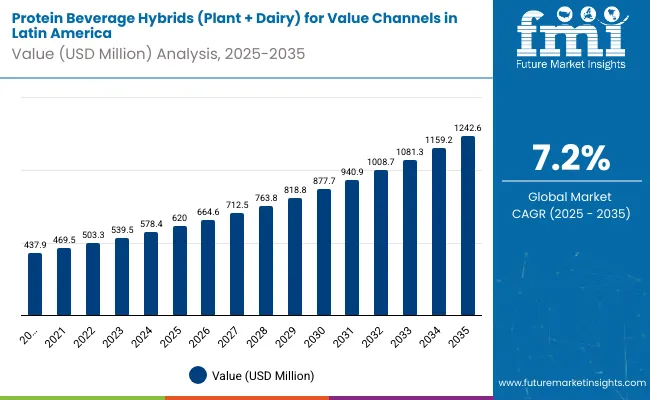
| Metric | Value |
|---|---|
| Industry Size (2025E) | USD 0.52 billion |
| Industry Value (2035F) | USD 1.48 billion |
| CAGR (2025 to 2035) | 11.0% |
This growth reflects both a broadening consumer base and increased per capita consumption in key urban centres. The rise in demand is linked to shifting dietary preferences, growing affordability concerns, and evolving convenience trends among price-conscious consumers.
By 2025, per capita consumption in leading Latin American countries such as Brazil, Mexico, and Argentina averages between 2.1 to 2.7 kilograms, with projections reaching 3.6 kilograms by 2035. São Paulo leads among metropolitan areas, expected to generate USD 156 million in protein hybrid beverage sales by 2035, followed by Mexico City (USD 121 million), Buenos Aires (USD 87 million), Bogotá (USD 64 million), and Lima (USD 42 million).
The largest contribution to demand continues to come from soy-whey protein combinations, which are expected to account for 64% of total sales in 2025, owing to cost efficiency, familiar taste profiles, and strong manufacturing capabilities across the region. By distribution channel, supermarkets and hypermarkets represent the dominant retail format, responsible for 47% of all sales, while convenience stores and independent retailers are expanding rapidly in rural and suburban areas.
Consumer adoption is particularly concentrated among budget-conscious families and flexitarian consumers, with household income levels and regional preferences emerging as significant drivers of demand. While taste acceptance remains a key factor, the average price discount compared to premium dairy protein beverages has improved from 42% in 2020 to 35% in 2025.
Continued improvements in local sourcing and regional manufacturing are expected to accelerate accessibility across lower-income households. Regional disparities persist, but per capita demand in emerging Central American and Caribbean nations is narrowing the gap with traditionally strong South American hubs.
The protein beverage hybrids for value channels segment in Latin America is classified across several segments. By protein blend, the key categories include soy-whey combinations, pea-casein formulations, rice-milk protein blends, and multi-source hybrid proteins. By distribution channel, the segment spans supermarkets and hypermarkets, convenience stores, independent retailers, wholesalers and distributors, and direct-to-consumer platforms. By price positioning, formulations include economy tier, value tier, mid-range affordable, and premium accessible categories.
By consumer profile, the segment covers budget-conscious families, flexitarian households, health-aware price shoppers, young urban professionals, and rural expanding demographics. By region, countries such as Brazil, Mexico, Argentina, Colombia, and Chile are included, along with coverage across all Latin American nations. By city, key metro areas analyzed include São Paulo, Mexico City, Buenos Aires, Bogotá, and Lima.
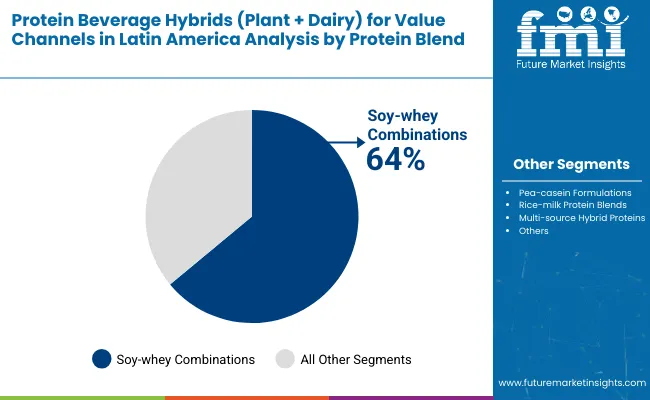
Soy-whey protein combinations are projected to dominate sales in 2025, supported by cost optimization, established supply chains, and consumer familiarity. Other formats such as pea-casein, rice-milk protein, and multi-source blends are growing steadily, each serving distinct nutritional and economic needs.
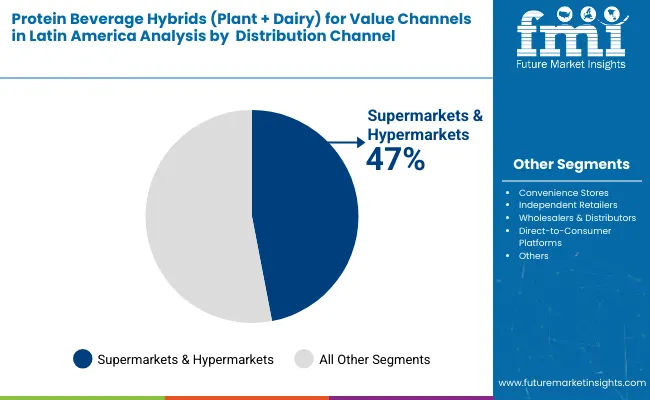
Protein beverage hybrids in Latin America are distributed through a mix of modern retail and traditional sales channels. Supermarkets and hypermarkets are expected to remain the primary point of sale in 2025, followed by convenience stores and independent retailers. Distribution strategies are evolving to match consumer shopping behavior, with growth coming from both organized retail and informal trade channels.
Protein beverage hybrids in Latin America utilize various price positioning strategies, selected for affordability, value perception, and market accessibility. Economy tier products remain the most widely adopted positioning, though value tier and affordable mid-range categories are gaining momentum. Product developers are increasingly exploring cost optimization to meet evolving economic constraints and purchasing power limitations.
The protein beverage hybrids category appeals to a diverse consumer base across income levels, dietary preferences, and lifestyle needs. While motivations vary from affordability to health consciousness to convenience, demand is concentrated among five key demographic clusters. Each group brings distinct purchase behaviors, channel preferences, and product expectations.
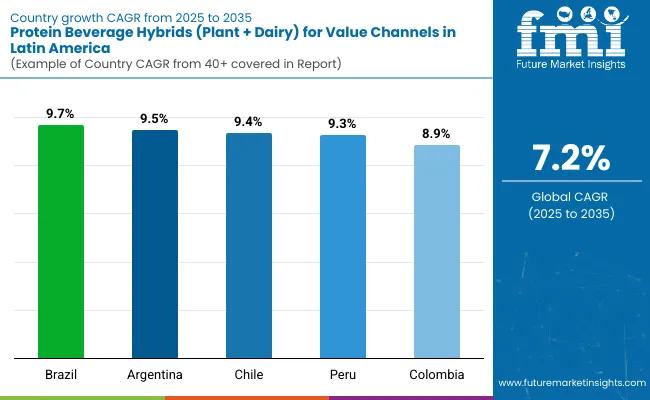
Protein beverage hybrid sales will not grow uniformly across every metropolitan area. Rising health consciousness and faster urban development in secondary cities give Bogotá and Lima a measurable edge, while established primary markets such as São Paulo expand more steadily from a higher base. The table below shows the compound annual growth rate (CAGR) each of the five largest cities is expected to record between 2025 and 2035.
Brazil is set to anchor regional growth in protein beverage hybrids, outpacing peers CAGR analysis indicates Brazil will lead Latin America’s expansion in plant-dairy protein hybrids, propelled by broad retail penetration, local production efficiencies, and rapid consumer adoption in both mainstream and value segments. Colombia and Mexico emerge as secondary growth engines, benefiting from targeted functional-beverage positioning and urban middle-class demand.
Chile and Argentina are expected to post moderate, steady gains, reflecting macroeconomic headwinds but supported by innovation in premium and fortified offerings. The regional growth profile underscores Brazil’s outsized role as a demand catalyst, while secondary markets provide diversification and resilience to category growth.
Between 2025 and 2035, demand for protein beverage hybrids is projected to expand across all major Latin American metropolitan areas, but the pace of growth will vary based on economic development, retail modernization, and baseline consumption levels. Among the top five cities analyzed, Bogotá and Lima are expected to register the fastest compound annual growth rate (CAGR) of 3.45%, outpacing more mature primary markets.
This acceleration is underpinned by a combination of factors: expanding middle class populations, improving retail infrastructure, and increasing availability of affordable protein products across modern trade and traditional channels. In both cities, per capita consumption is projected to rise from 2.3 kg in 2025 to 3.2 kg by 2035, closing the gap with higher-consumption cities such as São Paulo and Mexico City. Retail assortment is also expanding faster in these regions, with new protein hybrid formats gaining traction in supermarkets, convenience stores, and independent retailers.
Buenos Aires and Mexico City are each forecast to grow at a CAGR of 3.12% over the same period. Both cities already maintain established modern retail ecosystems, with widespread access to protein beverage hybrids across supermarkets, hypermarkets, and convenience store networks. In Buenos Aires, growth is supported by a strong dairy heritage, local manufacturing capabilities, and increasing consumer interest in affordable nutrition solutions.
Mexico City reflects similar dynamics, particularly among working families and health-conscious consumers seeking accessible protein supplementation. In both cities, per capita consumption is projected to increase from 2.6 kg in 2025 to 3.5 kg by 2035, reflecting mainstreaming of hybrid protein convenience options.
São Paulo, while maintaining the highest overall sales in absolute terms, is expected to grow at a CAGR of 2.89%, slightly below its secondary market counterparts. The city already exhibits higher-than-average per capita intake (2.8 kg in 2025), extensive product saturation, and a dense retail network. Growth will likely come from product innovation, premium value segments, and format diversification rather than first-time category adoption.
Collectively, these five metropolitan areas represent the core of urban demand for protein beverage hybrids in Latin America, but their individual growth paths highlight the importance of regional tailoring in pricing, product formulation, and channel strategy.
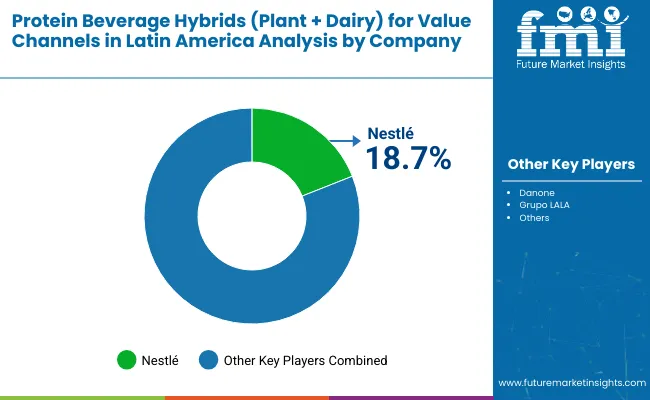
The competitive environment is characterized by a mix of established multinational food companies and regional dairy and beverage manufacturers. Local sourcing capabilities and value pricing rather than premium positioning remains the decisive success factor: the five largest suppliers collectively reach more than 45,000 retail outlets across Latin America and account for a majority of protein hybrid beverage shelf facings in the category.
Nestlé Latin America is the most established participant in the regional protein beverage space. The Swiss company offers affordable protein hybrid solutions including plant-dairy combinations across multiple brands. Its core distribution network gives it deep penetration in modern retail while maintaining extensive coverage through traditional trade channels and independent retailers across major Latin American markets.
Danone Latin America, part of the French multinational, leverages its dairy expertise and plant-based innovation to supply protein hybrid beverages to value-conscious consumers across the region. Post-acquisition integration of local dairy operations has allowed Danone to introduce cost-optimized hybrid formulations that maintain nutritional quality while achieving competitive pricing for mass market accessibility.
Unilever Latin America benefits from scale synergies within a diversified portfolio and from established relationships with regional retailers and distributors. Recent investments under various beverage brands extend Unilever beyond traditional categories into affordable protein hybrid concepts specifically targeting price-sensitive nutrition seekers.
The next tier comprises regional dairy companies and emerging local manufacturers. Grupo Lala focuses on dairy-plant protein combinations leveraging its strong dairy base in Mexico and expanding presence across Central America. BRF S.A., despite its primary protein focus, maintains growing beverage operations through specialized hybrid formulations designed for Brazilian and regional mass market applications.
Private label programs at major retailers like Walmart Mexico, Carrefour Brasil, and regional chains like Cencosud are expanding protein hybrid availability at price points 25-30% below branded equivalents, creating competitive pressure while supporting category trial. Regional manufacturing partnerships and local ingredient sourcing are therefore likely to become critical for maintaining market access and price competitiveness in this value-focused segment.
| Attribute | Details |
|---|---|
| Study Coverage | Latin America sales and consumption of protein beverage hybrids for value channels from 2020 to 2035 |
| Base Year | 2025 |
| Historical Data | 2020 |
| Forecast Period | 2025-2035 |
| Units of Measurement | USD (sales), Metric Tonnes (volume), Kilograms per capita (consumption) |
| Geography Covered | All Latin American countries; country-level and city-level granularity |
| Top Countries Analyzed | Brazil, Mexico, Argentina, Colombia, Chile, Peru, Venezuela |
| Top Cities Analyzed | São Paulo, Mexico City, Buenos Aires, Bogotá, Lima, Santiago, Caracas |
| By Protein Blend | Soy-whey combinations, Pea-casein formulations, Rice-milk protein, Multi-source hybrids |
| By Distribution Channel | Supermarkets/hypermarkets, Convenience stores, Independent retailers, Wholesalers, Direct-to-consumer |
| By Price Positioning | Economy tier, Value tier, Mid-range affordable, Premium accessible |
| By Consumer Profile | Budget-conscious families, Flexitarian households, Health-aware price shoppers, Young urban professionals, Rural expanding demographics |
| Metrics Provided | Sales (USD), Volume (MT), Per capita consumption (kg), CAGR (2025-2035), Share by segment |
| Price Analysis | Average unit prices by protein blend and region |
| Competitive Landscape | Company profiles, local sourcing strategies, value positioning approaches |
| Forecast Drivers | Per capita demand trends, retail expansion, economic development, affordability improvements |
By 2035, total Latin America sales of protein beverage hybrids for value channels are projected to reach USD 1.24 billion, up from USD 0.62 billion in 2025, reflecting a CAGR of approximately 7.2%.
Soy-whey combinations hold the leading share, accounting for approximately 64% of total sales in 2025, followed by pea-casein formulations and rice-milk protein blends.
Bogotá and Lima lead in projected growth, each registering a CAGR of 3.45% between 2025 and 2035, due to expanding middle class populations and improving retail infrastructure.
Supermarkets and hypermarkets are the dominant sales channel (47% share in 2025), but convenience stores and independent retailers are growing rapidly, especially in suburban and rural areas.
Major players include Nestlé Latin America, Danone, Unilever, Grupo Lala, BRF S.A., and Alpina Productos Alimenticios, with growing competition from private label brands and regional manufacturers.






Our Research Products

The "Full Research Suite" delivers actionable market intel, deep dives on markets or technologies, so clients act faster, cut risk, and unlock growth.

The Leaderboard benchmarks and ranks top vendors, classifying them as Established Leaders, Leading Challengers, or Disruptors & Challengers.

Locates where complements amplify value and substitutes erode it, forecasting net impact by horizon

We deliver granular, decision-grade intel: market sizing, 5-year forecasts, pricing, adoption, usage, revenue, and operational KPIs—plus competitor tracking, regulation, and value chains—across 60 countries broadly.

Spot the shifts before they hit your P&L. We track inflection points, adoption curves, pricing moves, and ecosystem plays to show where demand is heading, why it is changing, and what to do next across high-growth markets and disruptive tech

Real-time reads of user behavior. We track shifting priorities, perceptions of today’s and next-gen services, and provider experience, then pace how fast tech moves from trial to adoption, blending buyer, consumer, and channel inputs with social signals (#WhySwitch, #UX).

Partner with our analyst team to build a custom report designed around your business priorities. From analysing market trends to assessing competitors or crafting bespoke datasets, we tailor insights to your needs.
Supplier Intelligence
Discovery & Profiling
Capacity & Footprint
Performance & Risk
Compliance & Governance
Commercial Readiness
Who Supplies Whom
Scorecards & Shortlists
Playbooks & Docs
Category Intelligence
Definition & Scope
Demand & Use Cases
Cost Drivers
Market Structure
Supply Chain Map
Trade & Policy
Operating Norms
Deliverables
Buyer Intelligence
Account Basics
Spend & Scope
Procurement Model
Vendor Requirements
Terms & Policies
Entry Strategy
Pain Points & Triggers
Outputs
Pricing Analysis
Benchmarks
Trends
Should-Cost
Indexation
Landed Cost
Commercial Terms
Deliverables
Brand Analysis
Positioning & Value Prop
Share & Presence
Customer Evidence
Go-to-Market
Digital & Reputation
Compliance & Trust
KPIs & Gaps
Outputs
Full Research Suite comprises of:
Market outlook & trends analysis
Interviews & case studies
Strategic recommendations
Vendor profiles & capabilities analysis
5-year forecasts
8 regions and 60+ country-level data splits
Market segment data splits
12 months of continuous data updates
DELIVERED AS:
PDF EXCEL ONLINE
Latin America Fish Protein Market Trends – Size, Growth & Forecast 2025–2035
Latin America Fungal Protein Market Outlook – Growth, Demand & Forecast 2025–2035
Latin America Chickpea Protein Market Analysis – Demand, Share & Forecast 2025–2035
Latin America Non-Alcoholic Malt Beverages Market Trends – Growth & Forecast 2025–2035
Latin America Hydrolyzed Vegetable Protein Market Insights – Size & Forecast 2025–2035
Latin America Animal Feed Alternative Protein Market Analysis – Growth & Forecast 2025–2035
Demand for Protein-rich Shelf-stable UHT Oat Drinks in Latin America Size and Share Forecast Outlook 2025 to 2035
Latin America Joint Compound Industry Analysis Size and Share Forecast Outlook 2025 to 2035
Latin America In-mold Labels Market Size and Share Forecast Outlook 2025 to 2035
Latin America Rigid Industrial Packaging Market Size and Share Forecast Outlook 2025 to 2035
Latin America Hand Sanitizer Market Size and Share Forecast Outlook 2025 to 2035
Latin America Hand Soap Market Size and Share Forecast Outlook 2025 to 2035
Latin America Hydraulic Filtration Market Size and Share Forecast Outlook 2025 to 2035
Latin America Automotive HVAC Market Size and Share Forecast Outlook 2025 to 2035
Latin America Frozen Ready Meals Market Insights – Demand & Forecast 2025–2035
Latin America Aqua Feed Additives Market Trends – Growth & Forecast 2025–2035
Latin America Collagen Peptide Market Report – Trends, Size & Forecast 2025–2035
Latin America Bubble Tea Market Outlook – Growth, Trends & Forecast 2025–2035
Latin America Shrimp Market Report – Trends, Growth & Forecast 2025–2035
Latin America Cultured Wheat Market Outlook – Growth, Demand & Forecast 2025–2035

Thank you!
You will receive an email from our Business Development Manager. Please be sure to check your SPAM/JUNK folder too.
Chat With
MaRIA